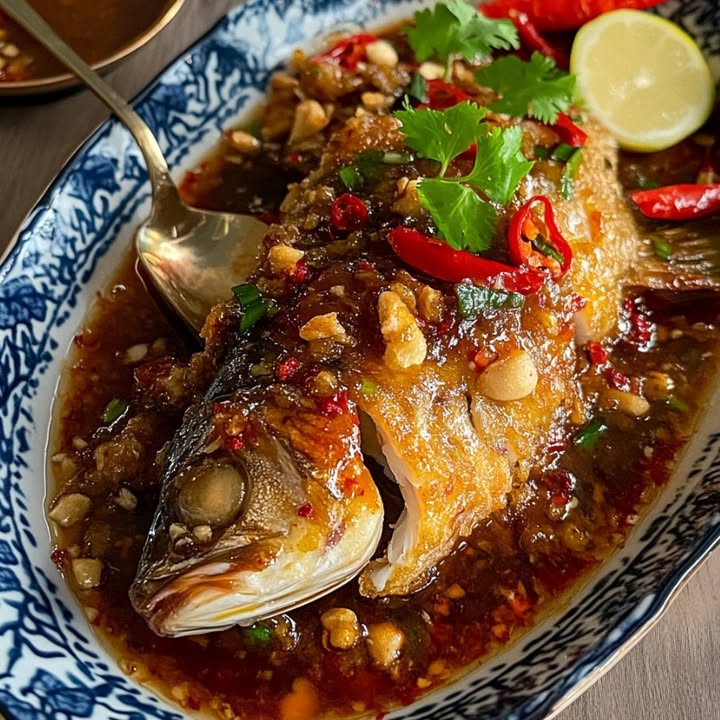
Why Crispy Tamarind Fish is a Must-Try Dish
Picture this: it’s a Friday evening, and I’m craving something that screams comfort but also feels like a mini vacation for my taste buds. Enter Crispy Tamarind Fish, a dish so vibrant and flavorful that it instantly transports you to the bustling streets of Thailand. With its crispy golden exterior, tangy tamarind sauce, and just the right kick of spice, this recipe has quickly become a family favorite. I first tried making it on a whim after a friend raved about her travels to Bangkok, and now? It’s a regular at our dinner table. Trust me, once you try it, you’ll see why it’s worth every minute in the kitchen.
The Story Behind This Tasty Thai Treat
This dish is deeply rooted in Thai cuisine, where balance is key. The combination of sweet, sour, salty, and spicy flavors reflects the essence of Thai cooking. Traditionally made with tilapia or other white fish, this recipe uses simple ingredients to create a symphony of taste. When I first tested it, I was amazed at how something so straightforward could pack such a punch. The crispy texture of the fish paired with the glossy, sticky tamarind sauce is pure magic. Plus, it’s versatile enough to be served at casual dinners or fancy gatherings.
Why You’ll Fall in Love with This Recipe
If you’re looking for a dish that’s both comforting and exciting, look no further. Crispy Tamarind Fish offers layers of flavor that keep you coming back for more. The sauce is tangy from the tamarind paste, slightly sweet from palm sugar, and savory from the fish sauce. And let’s not forget the crunch! The crispy coating adds a satisfying contrast to the tender fish inside. What makes this recipe even better? It’s surprisingly easy to make. No need to be a pro chef—just follow the steps, and you’ll have a restaurant-worthy dish in no time.
Perfect Occasions to Whip Up This Dish
Whether you’re hosting a dinner party, celebrating a special occasion, or simply treating your family to a tasty weeknight meal, this dish fits the bill. I love serving it during holidays when everyone wants something indulgent yet refreshing. It’s also perfect for potlucks because it’s unique and sure to impress. Pair it with steamed rice or a fresh salad for a complete meal that will leave your guests talking long after dessert.
Ingredients You’ll Need
- 1 kg of tilapia (or any firm white fish)
- Cornstarch for coating the fish
- Oil for frying
- A handful of fresh and dried chilies, depending on your spice tolerance
- 10 garlic cloves
- 1 tablespoon cornstarch for thickening the sauce
- 2 tablespoons water for thickening the sauce
- 4.5 tablespoons palm sugar
- 5 tablespoons tamarind paste
- 7 tablespoons fish sauce
- 10 ml water
Substitution Options
No tilapia? No problem! Use cod, snapper, or even catfish. If you’re out of palm sugar, brown sugar works fine. For those who can’t handle too much heat, skip the dried chilies and use milder fresh ones. And if you don’t have tamarind paste, lemon juice mixed with a bit of brown sugar can mimic the sour-sweet flavor. Feel free to swap vegetable oil for peanut oil for an extra nutty aroma while frying.
Step 1: Preparing the Fish
Start by giving your tilapia a good rinse under cold water. Pat it dry thoroughly—trust me, soggy fish won’t crisp up nicely. Make diagonal cuts on both sides of the fish; these help the flavors penetrate deeper. Now, coat the fish evenly with cornstarch. Don’t skimp here—the starch is what gives the fish its irresistible crunch. Pro tip: Let the coated fish sit for 5 minutes before frying to ensure the coating sticks well.
Step 2: Frying the Fish
Heat your oil in a deep pan over medium heat. You want enough oil to submerge half the fish at a time. Once the oil is shimmering, gently place the fish in the pan. Fry each side for about 8 minutes until golden brown and crispy. Be patient—flipping too soon can cause the coating to peel off. Adjust the frying time based on the size of your fish. Once done, transfer the fish to a wire rack to drain excess oil.
Step 3: Making the Tamarind Sauce
In a mortar and pestle, mash the garlic and chilies into a fragrant paste. In a separate bowl, mix the cornstarch with water to create a slurry. Heat oil in a saucepan and sauté the garlic-chili paste until aromatic. Add palm sugar, tamarind paste, fish sauce, and a splash of water. Stir in the cornstarch mixture and cook until the sauce thickens and turns glossy. Chef’s tip: Taste as you go and adjust the sweetness or saltiness to suit your preference.
Step 4: Serving
Place the crispy fish on a serving platter and pour the warm tamarind sauce generously over the top. Garnish with additional fresh or dried chilies for a pop of color and extra heat. Serve immediately with steamed jasmine rice or noodles for a truly authentic experience.
Timing Breakdown
- Preparation Time: 10 minutes
- Cooking Time: 40 minutes
- Total Time: 50 minutes
Chef’s Secret
For an extra layer of flavor, marinate the fish with a pinch of salt and turmeric before coating it with cornstarch. This little trick enhances the overall taste without overpowering the dish.
Fun Fact About Tamarind
Tamarind isn’t just delicious—it’s also packed with health benefits! Rich in antioxidants and vitamins, it’s been used in traditional medicine for centuries. Fun fact: Did you know tamarind trees can live for over 200 years? That’s longevity we can all aspire to!
Necessary Equipment
- Deep frying pan
- Mortar and pestle
- Saucepan
- Wire rack or strainer
- Slotted spoon
Storage Tips
To store leftover Crispy Tamarind Fish, refrigerate the fish and sauce separately in airtight containers. Reheat the fish in the oven at 350°F for 10 minutes to retain its crispiness. Avoid microwaving, as it can make the coating soggy. The sauce can be reheated on the stovetop with a splash of water to loosen it up.
If you plan to freeze the dish, wrap the fish tightly in plastic wrap and foil. Thaw overnight in the fridge before reheating. Unfortunately, freezing may affect the texture slightly, so it’s best enjoyed fresh.
Leftovers are still tasty within 2-3 days, but the crunch factor diminishes over time. So, aim to eat it sooner rather than later!
Tips and Advice
Use a thermometer to check the oil temperature—it should be around 350°F for optimal frying. Keep the sauce consistency balanced; too thick, and it won’t coat the fish evenly. Too thin, and it might slide right off. Always taste-test the sauce before serving to ensure it hits the right notes of sweet, sour, and savory.
Presentation Ideas
- Garnish with lime wedges for a pop of color.
- Serve on a bed of shredded lettuce for a fresh touch.
- Add edible flowers for an elegant presentation.
- Drizzle extra sauce artistically around the plate.
Healthier Alternatives
Here are six ways to lighten up this dish:
- Baked Version: Coat the fish with cornstarch and bake at 400°F for 20 minutes instead of frying.
- Air-Fried Fish: Use an air fryer to achieve crispiness with less oil.
- Low-Sodium Option: Replace regular fish sauce with low-sodium soy sauce.
- Vegan Twist: Substitute fish with tofu or tempeh for a plant-based version.
- Less Sugar: Cut down on palm sugar and add a dash of honey for sweetness.
- Gluten-Free: Ensure all sauces and seasonings are gluten-free certified.
Mistake 1: Overcooking the Fish
Overcooked fish becomes dry and loses its delicate texture. To avoid this, monitor the frying time closely and remove the fish as soon as it turns golden brown. Pro tip: Use a meat thermometer to check the internal temperature—it should reach 145°F.
Mistake 2: Skipping the Drying Step
Wet fish leads to splattering oil and uneven browning. Always pat the fish dry with paper towels before coating it with cornstarch. This step ensures maximum crispiness.
Mistake 3: Rushing the Sauce
Cooking the sauce too quickly can result in lumps or uneven thickness. Stir constantly and cook over low heat to allow the flavors to meld beautifully.
Frequently Asked Questions
Can I use frozen fish?
Yes, but thaw it completely and pat it dry before using. Frozen fish contains more moisture, which can affect the crispiness.
What if I don’t have tamarind paste?
You can substitute with a mix of lemon juice and brown sugar. However, the flavor won’t be exactly the same.
Is this dish very spicy?
It depends on how many chilies you use. Adjust the quantity to suit your spice tolerance.
Can I prep this dish ahead of time?
Yes, you can prepare the sauce a day in advance and store it in the fridge. Fry the fish just before serving for the best results.
How do I know when the oil is ready?
Dip the end of a wooden spoon into the oil—if bubbles form steadily, it’s ready.
Final Thoughts
Crispy Tamarind Fish is more than just a recipe—it’s an experience. From the moment you start frying the fish to the final drizzle of glossy sauce, every step is filled with anticipation and joy. Whether you’re a seasoned cook or a beginner, this dish promises to delight your senses and bring smiles to your loved ones. So grab your apron, gather your ingredients, and let’s get cooking!

Crispy Tamarind Fish
Ingredients
Equipment
Method
- Rinse tilapia under cold water and pat dry thoroughly.
- Make diagonal cuts on both sides of the fish.
- Coat the fish evenly with cornstarch and let sit for 5 minutes.
- Heat oil in a deep pan over medium heat.
- Fry each side of the fish for about 8 minutes until golden brown and crispy.
- Transfer fish to a wire rack to drain excess oil.
- Mash garlic and chilies into a paste using a mortar and pestle.
- Mix cornstarch with water to create a slurry in a separate bowl.
- Sauté garlic-chili paste in a saucepan heated with oil until aromatic.
- Add palm sugar, tamarind paste, fish sauce, and a splash of water to the saucepan.
- Stir in the cornstarch mixture and cook until the sauce thickens and turns glossy.
- Place crispy fish on a serving platter and pour the warm tamarind sauce over it.
- Garnish with extra chilies before serving.
